Ever wished you could display content or functionality from another webpage directly within your own site, without forcing visitors to click away? Maybe you want to showcase a live demo, integrate a booking system, or display a partner's specific page. The common question is, how do you effectively embed a website in a website?
While the basic HTML involves an <iframe> tag, simply dropping that code isn't always reliable, easy to manage, or visually appealing. Furthermore, you often can't embed just any website due to security restrictions imposed by the target site itself.
This guide focuses on the smart way to handle website embedding using Poper. We'll show you how Poper simplifies the process of adding and managing these embeds when the target site allows it, and then we'll explain the underlying technology and limitations you need to understand.
Why Consider Embedding?
Unified User Experience: Keep visitors on your domain while providing external content.
Integrated Functionality: Display tools, portals, or specific pages from other sources.
Content Richness: Supplement your own content with relevant external displays.
How to Embed a Website in a Website Using Poper
Embedding content can keep users on your page longer and provide richer information right where they need it. Here’s how you can set this up using our platform.
Step 1: Get Set Up with Poper
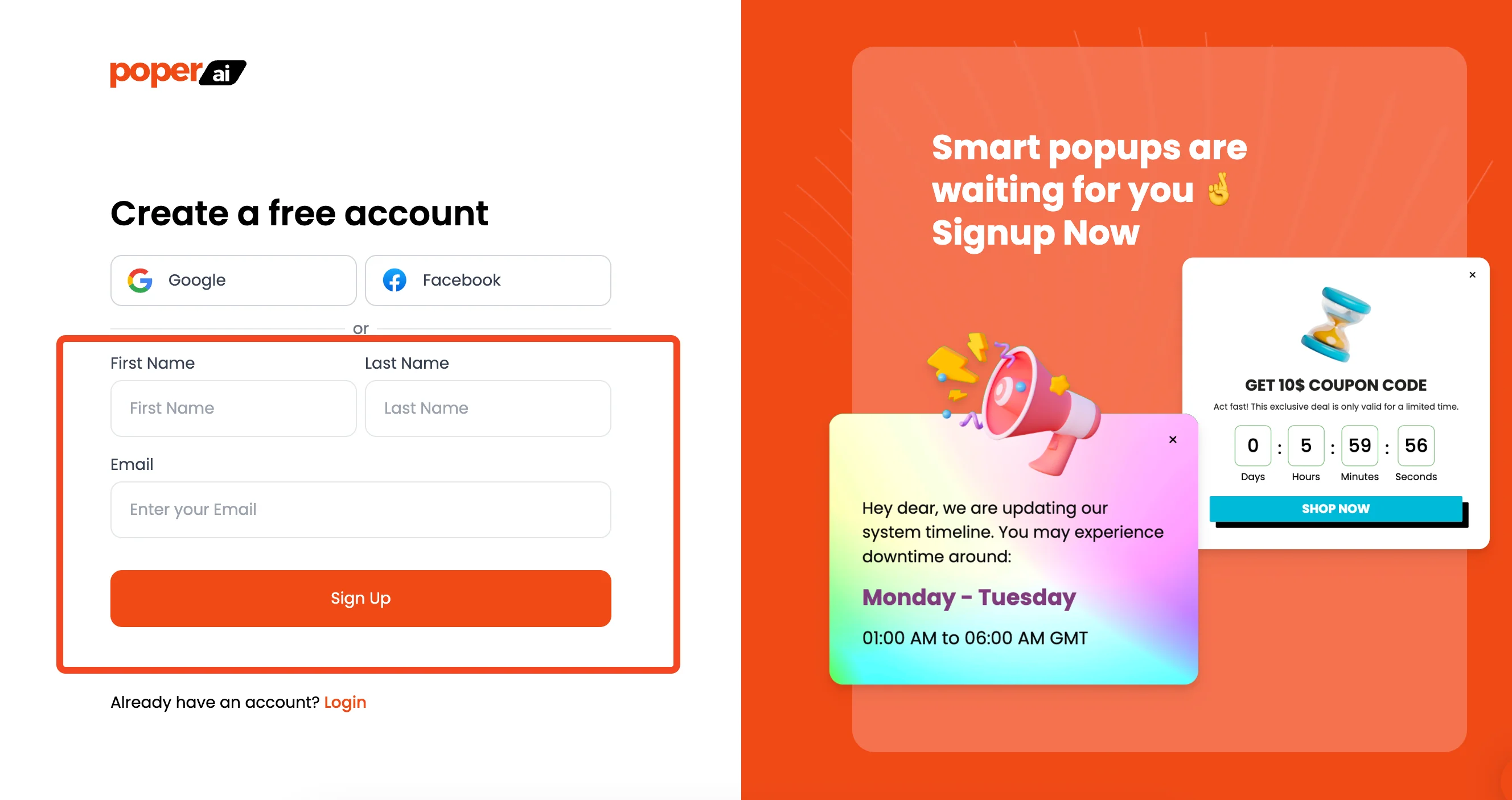
First things first, if you haven't already, you'll need a Poper account. Head over to our site and sign up. Once you're in, add the domain name (like yourwebsite.com) where you plan to show the embedded website. This tells Poper which site it needs to work with.
Step 2: Start a New Embed Campaign
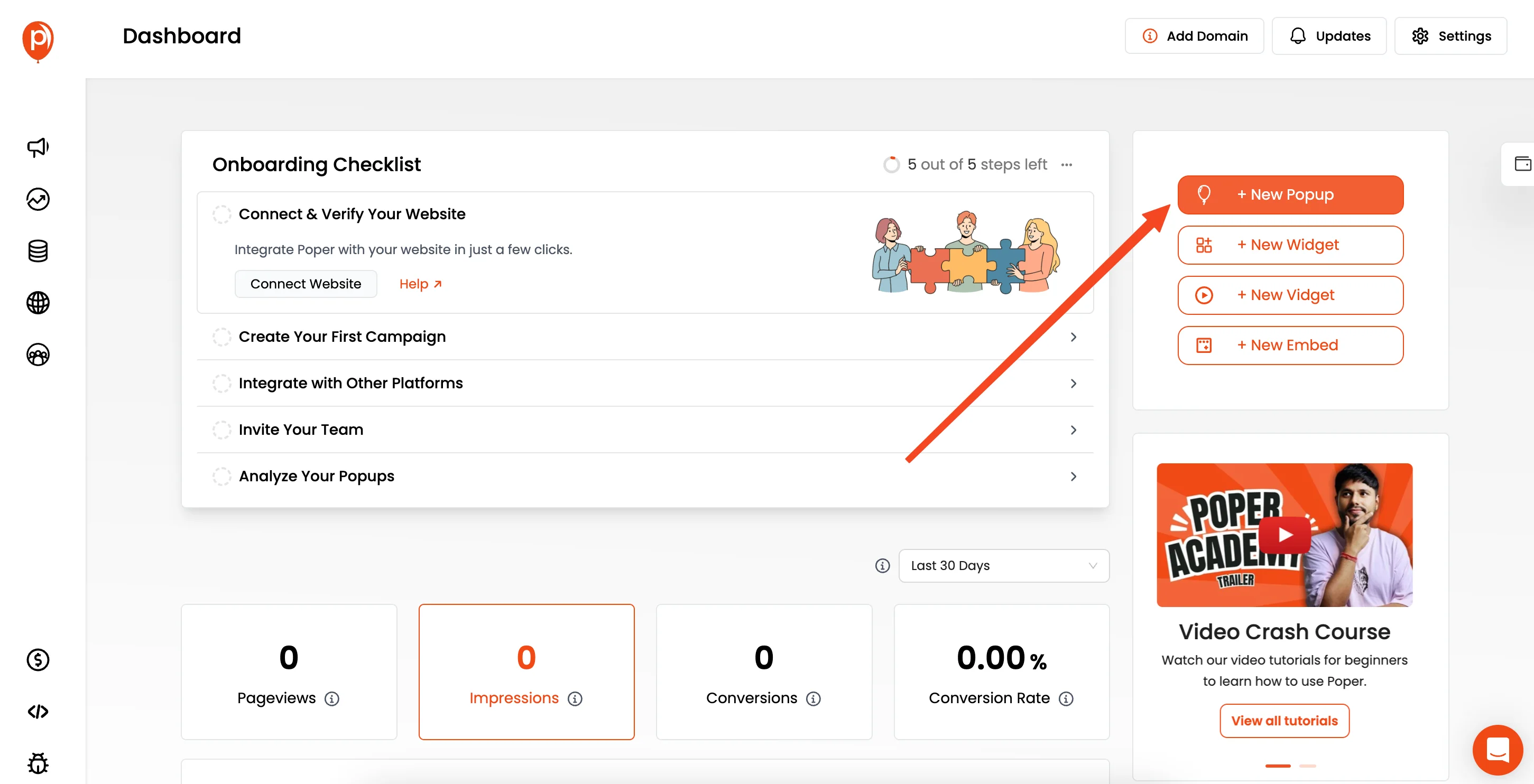
From your Poper dashboard, look for the button to create a new campaign – it might say something like "New Popup".
Click that, and when prompted, choose the option to "Start from Scratch." This gives you a blank canvas, perfect for adding custom elements like an embed.
Note: Don't worry, you can change from Popup to Embed later. We chose popup as it has "Start from Scratch" option.
Step 3: Generate Your Website Embed Code
To embed a website, you need a specific piece of HTML code called an iframe. I've actually built a simple tool just for this. Go to our iFrame Generator tool here: Iframe Generator.
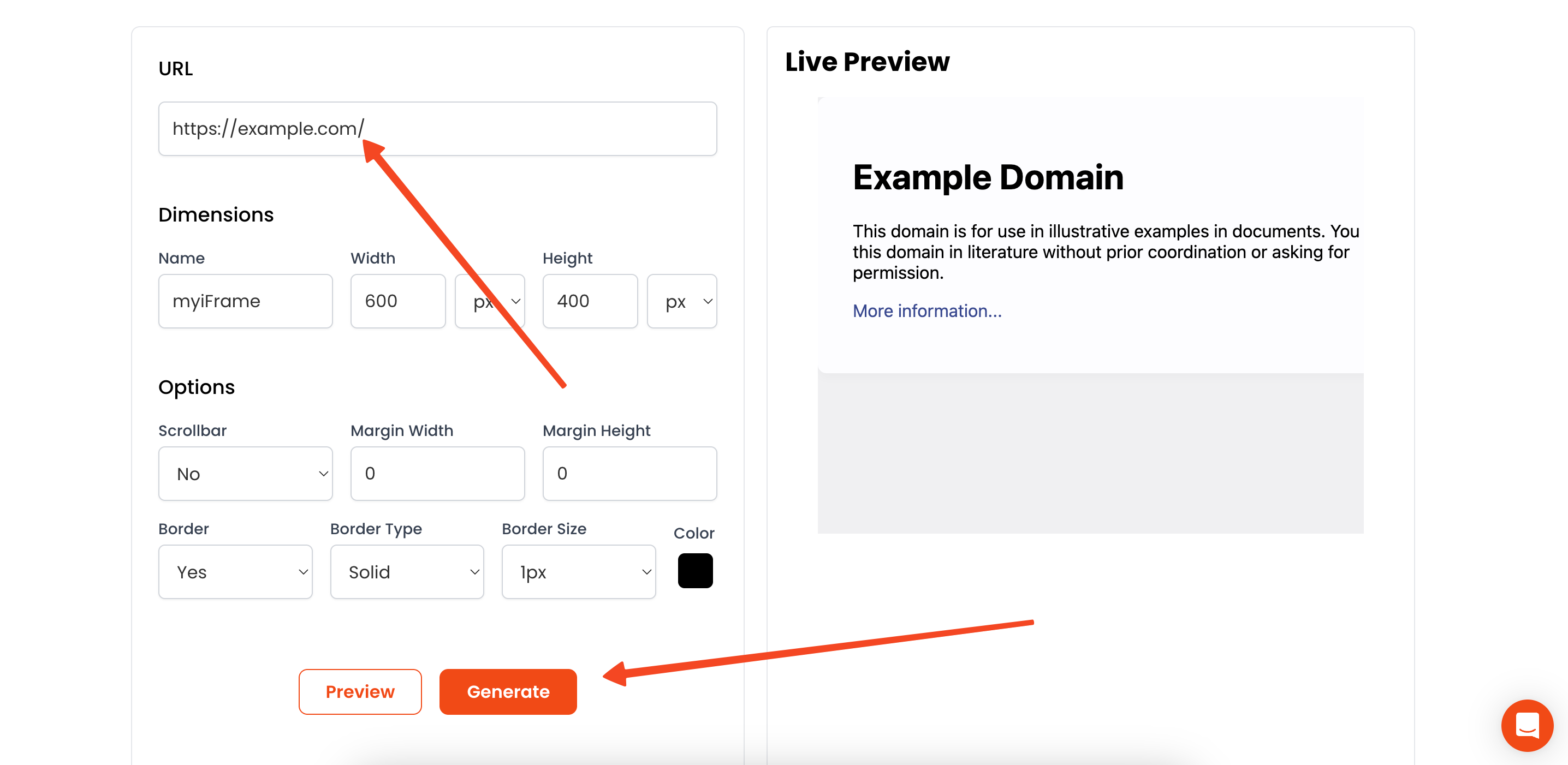
Paste the full URL of the website page you want to embed into the generator and copy the HTML code it gives you. This code tells the browser exactly what page to display inside your main page.
Step 4: Add the Embed Code to Your Poper Design

Now, head back to the Poper editor where you have your blank campaign. On the left-hand sidebar, find and click the "Add" tab.
This shows you all the different elements you can add to your design. Look for the "HTML" element and click it.
Step 5: Insert and Position the HTML Element
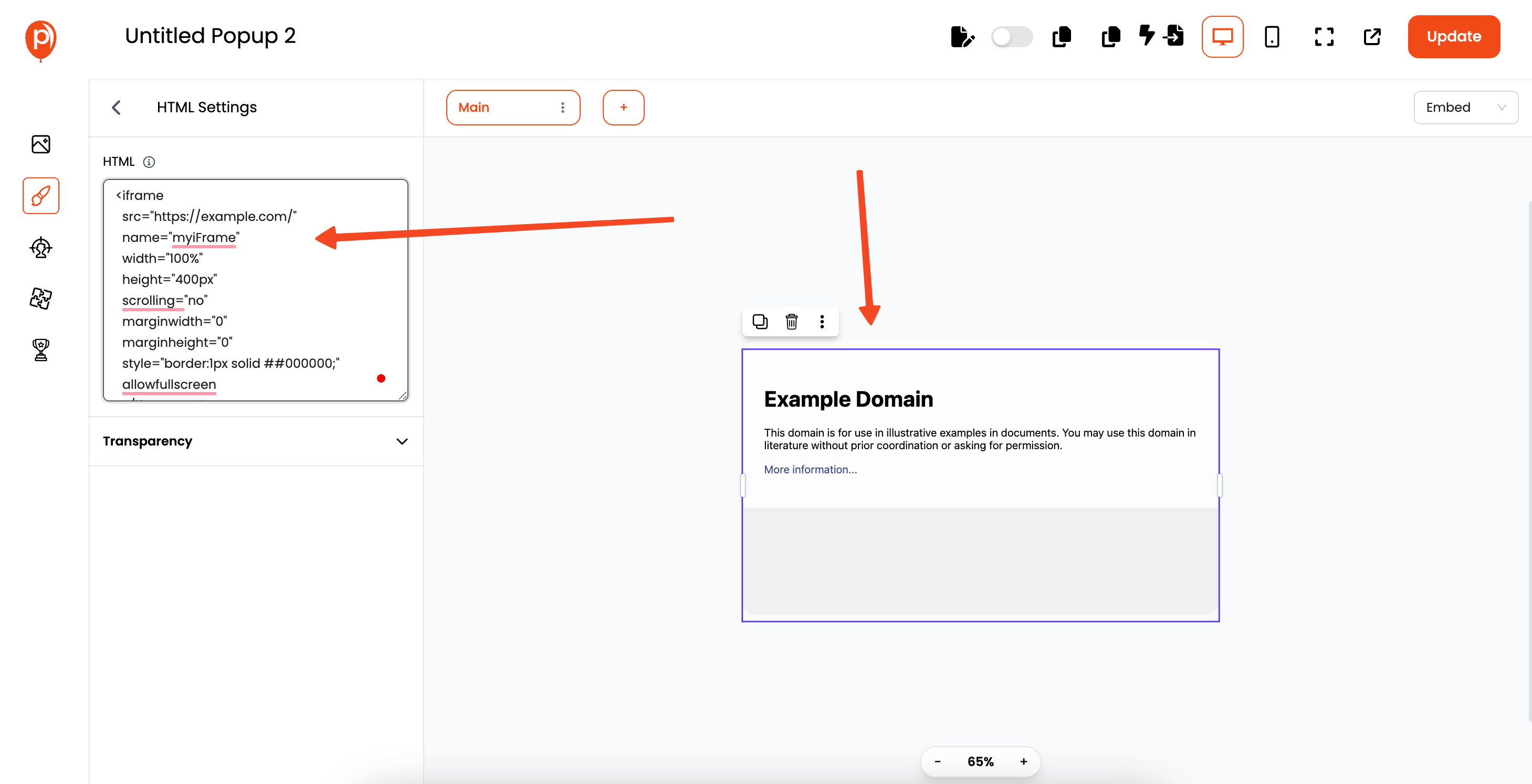
An HTML block will appear in your design canvas, and you'll see a field in the sidebar to paste code. Paste the iframe code you copied from our generator tool into this field.
You should see the website you want to embed appear within the element on your canvas. Now, simply drag and resize this HTML block to position the embedded website exactly where you want it on your page.
Step 6: Fine-Tune the Appearance (Optional)
If you want the embed to blend nicely, you can adjust its container. For instance, to get rounded corners, go to Global Settings > Dimensions > Overflow in the sidebar and set the overflow property to hidden.
This clips anything outside the element's boundaries, allowing border-radius effects to show cleanly.
Step 7: Convert Your Design to an Embed Type
This is a key step! By default, you might be editing a popup. We need to tell Poper this specific design should behave as an embed, meaning it loads directly within the page content.
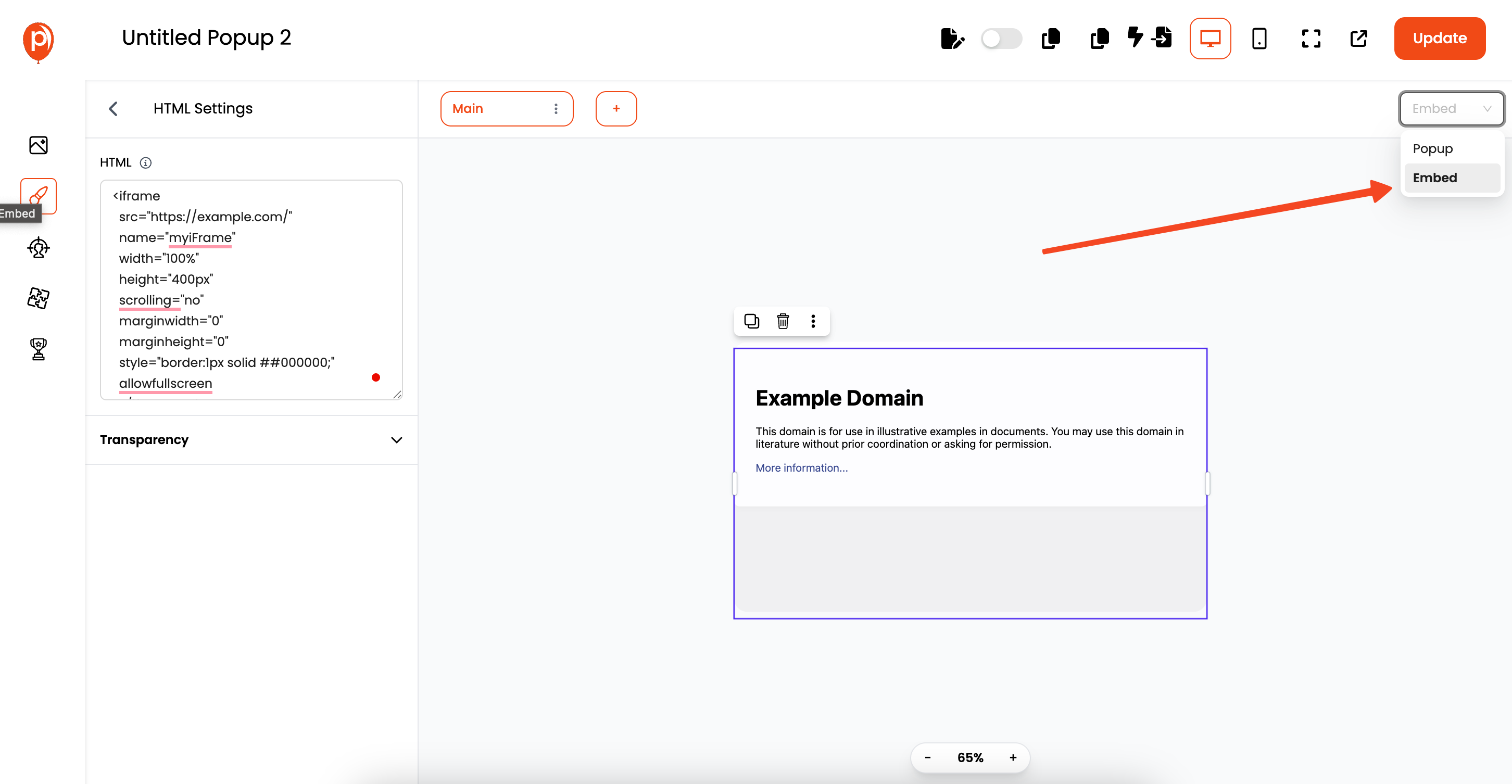
Look for a dropdown menu, usually near the top right of the editor, that lets you select the campaign type.
Change it from "Popup" (or whatever the default is) to "Embed". This ensures it integrates smoothly into your page structure.
Step 8: Set Display Conditions
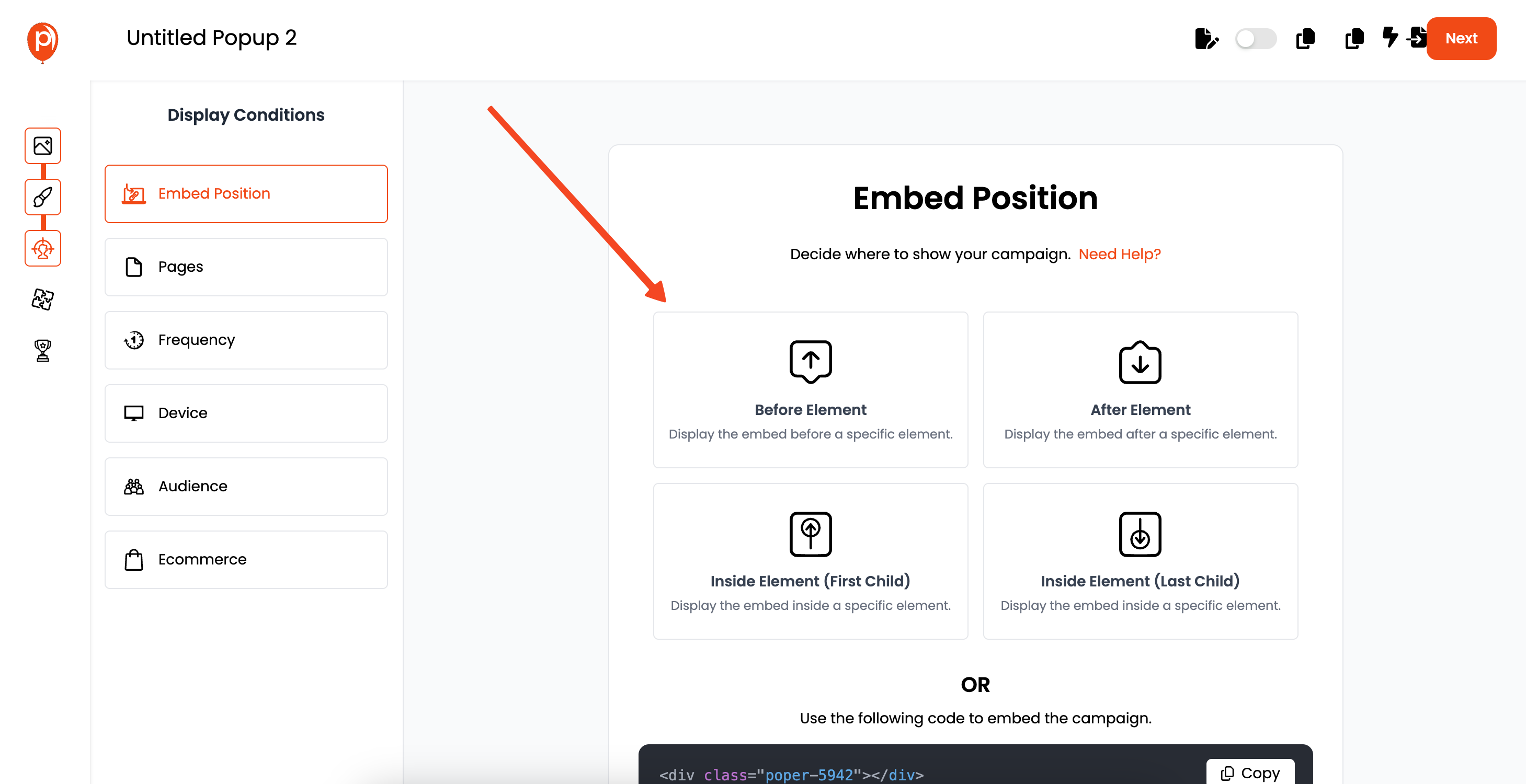
Decide where you want to display your Embed.
Step 9: Save and Publish Your Embed
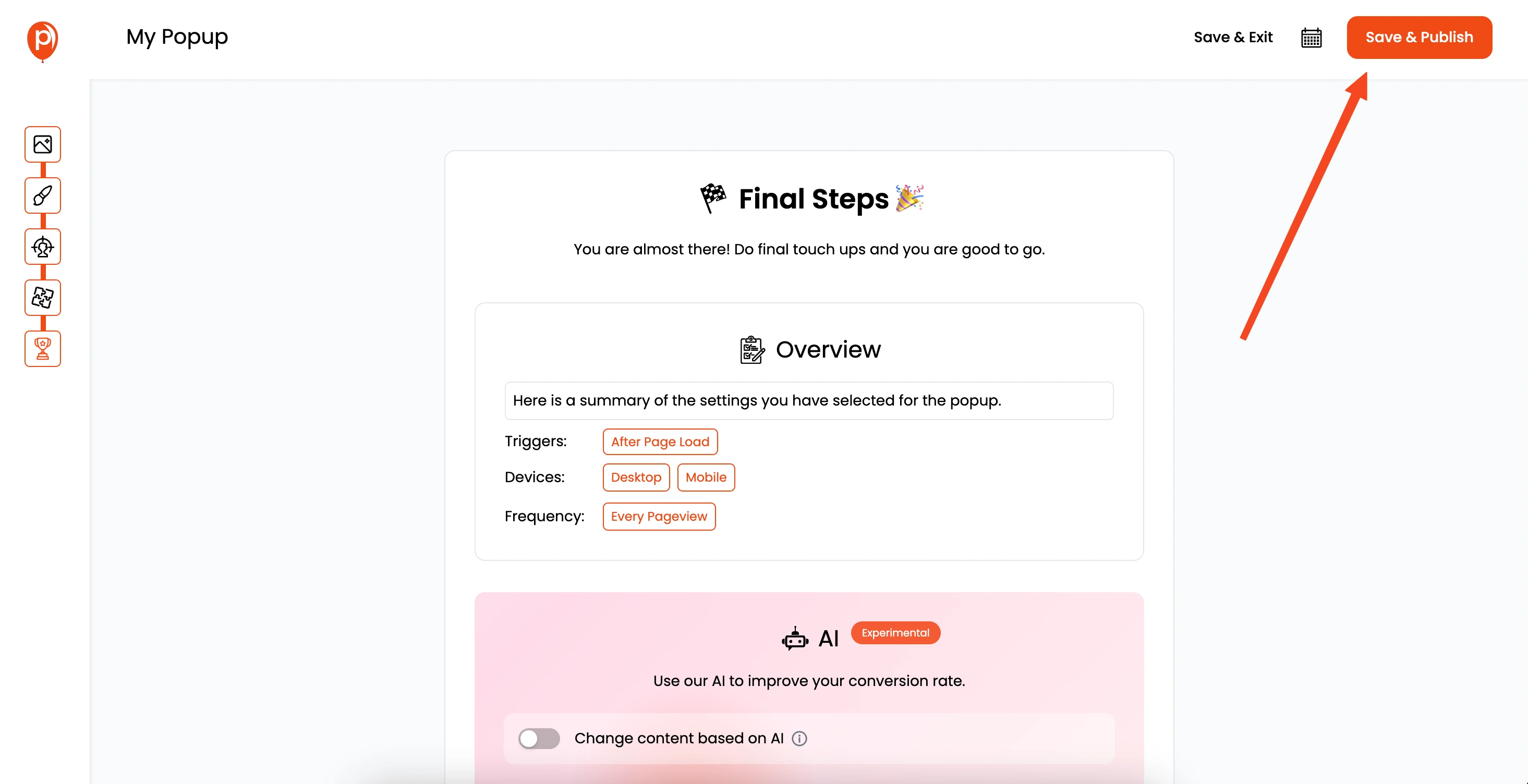
Once you're happy with the setup and how the embed looks, hit the "Save & Publish" button. This makes your embed live and ready to be displayed on your website, provided Poper is installed correctly.
Step 10: Install the Poper Code Snippet on Your Website
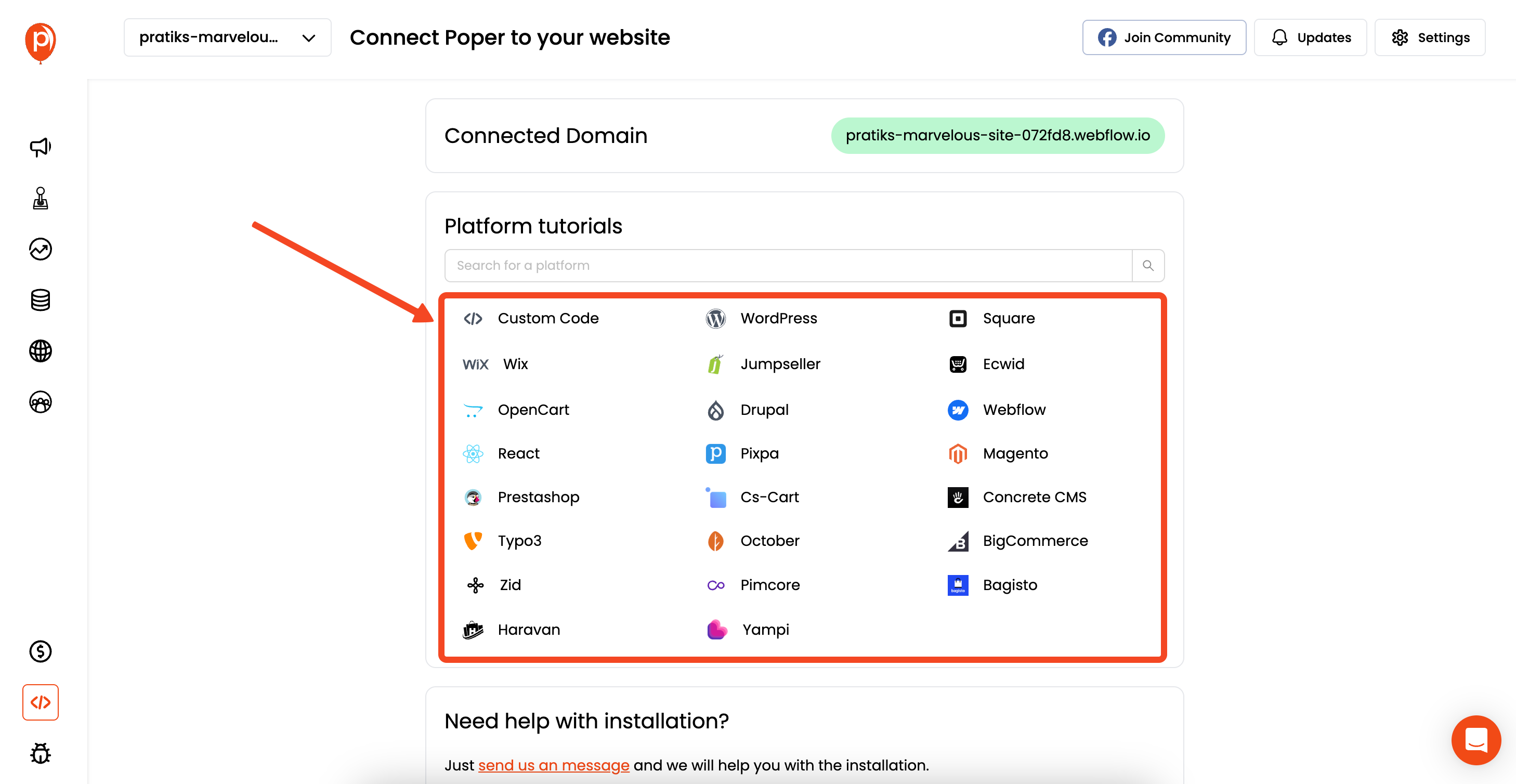
For the embed (or any Poper campaign) to show up on your live site, Poper needs to be connected. Go to the "Code" or "Installation" section in your Poper dashboard's main navigation.
Select your website platform (like Webflow, WordPress, etc.) and follow the instructions to add the Poper JavaScript snippet to your website's code, usually just before the closing </head> or </body> tag.
Step 11: Test Your Live Embed
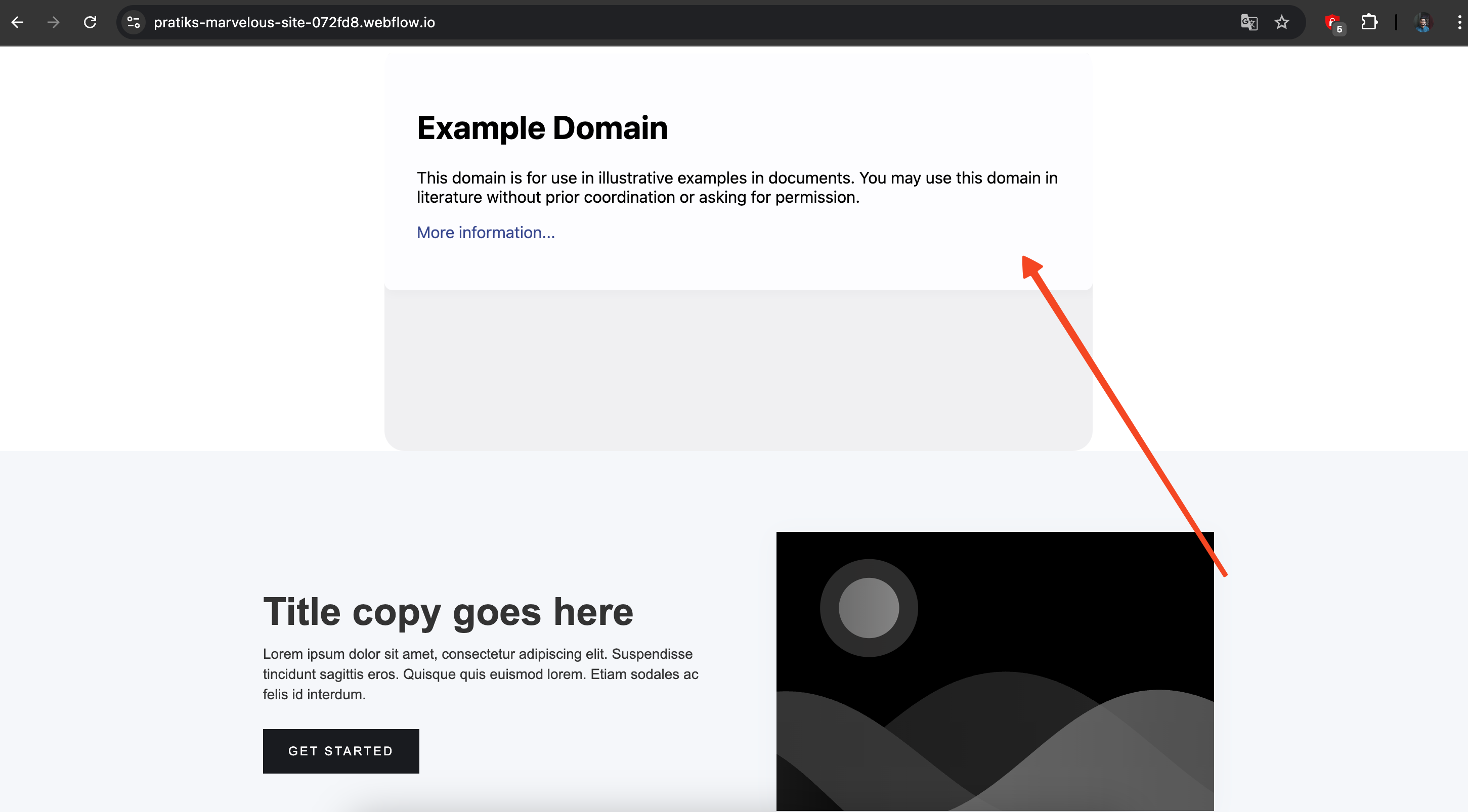
Finally, clear your browser cache and visit the page on your website where the embed should appear. Check that the embedded website loads correctly and looks how you intended. Make any adjustments back in the Poper editor if needed – changes usually update automatically after you republish.
That’s it! You’ve successfully embedded one website within another using Poper. It's a powerful way to integrate content seamlessly. Let me know if you run into any snags!
Managing Website Embeds: Manual iFrame vs. Poper
| Feature | Manual <iframe> Code in HTML | Poper Managed Embed (using <iframe>) |
| Placement | Manual HTML editing per location | Visual Editor + CSS Selectors |
| Container Styling | Requires custom CSS | Easy via Poper Style options |
| Updating URL/Settings | Edit HTML code on site | Update within Poper Dashboard |
| Targeting/Rules | Requires custom JS/backend logic | Uses Poper's built-in rules |
| Management | Decentralized (in page code) | Centralized (Poper Platform) |
| Ease for Non-Devs | Can be challenging | High |
Understanding iFrames and the "X-Frame-Options" Barrier
While Poper makes managing the process easier, it cannot override fundamental web security. The ability to embed a website in a website hinges on the target site's configuration.
What is an iFrame? It's the standard HTML tag (<iframe>) that creates the 'window' to display another webpage.
Why Can't I Embed Everything? For security reasons, websites can tell browsers not to allow themselves to be displayed inside an iframe on a different domain. This is primarily done using HTTP headers:
- X-Frame-Options: An older header with directives like DENY (no framing allowed) or SAMEORIGIN (only allows framing by pages on the exact same domain).
- Content-Security-Policy (CSP) frame-ancestors: A newer, more flexible header. Directives like 'none' (no framing) or 'self' (same origin) achieve the same goal. Many sites also use this to explicitly allow framing only from specific partner domains.
X-Frame-Options: An older header with directives like DENY (no framing allowed) or SAMEORIGIN (only allows framing by pages on the exact same domain).
Content-Security-Policy (CSP) frame-ancestors: A newer, more flexible header. Directives like 'none' (no framing) or 'self' (same origin) achieve the same goal. Many sites also use this to explicitly allow framing only from specific partner domains.
The Result: If you try to embed a website (using Poper or manual code) that sends X-Frame-Options: DENY or CSP: frame-ancestors 'none', your browser will respect the instruction and simply display a blank space or an error within the iframe. Poper cannot force a site to be embedded if it prohibits it.
Why the Restriction? Clickjacking: This security prevents malicious actors from embedding your legitimate site (like online banking) invisibly on their page and tricking users into clicking hidden buttons ("clickjacking").
How to Check if a Site Allows Embedding: Use your browser's Developer Tools (F12 -> Network tab), load the target URL, and inspect the Response Headers for X-Frame-Options or Content-Security-Policy.
Best Practices for Website Embedding
Check Permissions: Always assume a site might block embedding unless it's explicitly designed for it (like YouTube, Google Maps, or services providing embeddable widgets). Check headers if unsure.
Embed Your Own Content: Embedding pages from your own domain (SAMEORIGIN) is generally always allowed.
Use Official Embeds: Prioritize using the official embed code provided by services (if available) over trying to iframe their main website pages.
Consider Alternatives: If direct embedding is blocked, could you achieve your goal via API integration, linking, or summarizing the key information on your own site?
Responsiveness: Ensure your iframe container and the embedded content adapt reasonably to different screen sizes.
User Experience: Avoid embedding overly complex or heavy pages that might slow down your site or confuse users.
Conclusion: Embed Smartly, Understand the Limits
Embedding one website within another using an <iframe> is technically possible, but heavily restricted by the target website's security settings (X-Frame-Options, CSP). You cannot embed just any website.
Poper offers a powerful and user-friendly platform to manage the process of embedding websites when permitted, simplifying placement, styling, and updates without needing deep coding knowledge. However, it respects browser security and cannot bypass restrictions set by the target site.
Always verify if embedding is allowed, prioritize official embed methods when available, and use tools like Poper to streamline the management of your permitted embeds.
Frequently Asked Questions (FAQs)
Can Poper embed a website even if it has X-Frame-Options: DENY?
No. Poper operates within the rules of the browser. If a website instructs the browser not to allow framing via HTTP headers, Poper (and any other client-side method) cannot override that security measure. The iframe will appear blank or show an error.
How do I know if a website page allows embedding without checking headers?
Often, you don't know for sure without checking or simply trying to embed it. Sites designed to be embedded (like YouTube videos, Google Maps) usually work. Major websites, login pages, and sensitive applications almost always block embedding.
Is embedding a website bad for my site's SEO?
Content within an iframe from a different domain is typically not indexed by search engines as part of your hosting page. Relying on iframes for your core content is detrimental to SEO. Using it for supplementary tools or specific allowed external content is generally fine.
What are alternatives to embedding a website if it's blocked?
Consider:
* Linking: A simple link to the external site.
* APIs: If the service offers an API, you can pull data and display it natively on your site.
* Screenshots/Summaries: Describe or show static images of the external content.
* Official Widgets: Use embeddable widgets if the service provides them.Can I style the content inside the embedded website using Poper?
No. Due to the Same-Origin Policy, you (and Poper) cannot apply CSS styles directly to the content within an iframe loaded from a different domain. You can only style the container (the iframe element itself and its wrapper) using Poper's styling options.


